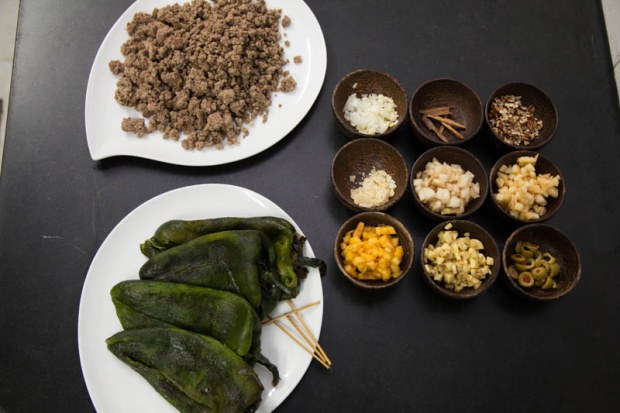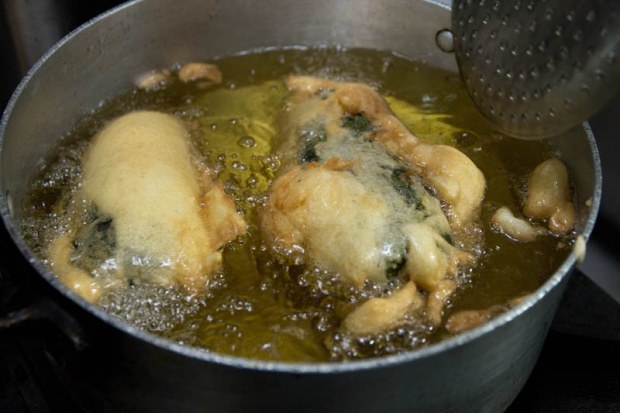Cancun has been graced with the birth of a new hotel. Dreams Sands is the new all-inclusive resort by AMResorts located right in the heart of the city’s Hotel Zone. In celebration of the hotel’s opening as well as Mexico’s independence month, Executive Chef Antonio Martinez and Sous Chef Hector Luna took the time to share with us the recipe for Mexico’s most patriotic dish—chile en nogada, or stuffed poblano peppers in a walnut cream sauce.

Mexico is a country rich in culinary tradition. Forged from the fusion of indigenous and European cuisine, Mexican food is just as diverse as it is delicious. And while each region has its signature dishes, in August and September one dish stands out above the rest for its intricate preparation using a variety of complex spices and ingredients to achieve a sensational taste.
Chile en Nogada – what is it?

Few other dishes are so bound to Mexican culinary identity like chile en nogada. Not only does this recipe call for a proud display of the colors of Mexico, but its history is also linked to the founding of Mexico as a nation. Executive Chef Antonio Martinez from Dreams Sands Resort & Spa in Cancun takes us on a culinary journey to discover the history and flavors of this wonderful dish.
History of Chiles en Nogadas – A Gift to the Emperor

What is a history of Chles en Nagada? In August of 1821, military commander Augustin de Iturbide signed the Treaty of Cordoba in the city of the same name in the state of Veracruz, thus putting a successful end the country’s War of Independence against the Spanish Crown.
On his way back to Mexico City, Iturbide, who would soon become Emperor Augustin I, passed through the beautiful town of Puebla. Knowing of his arrival and wanting to offer a celebration worthy of the father of independence, while also thankful of his intention to grant religious freedom, the Augustin nuns from the Santa Monica convent decided to prepare something special. Gathering together the different products that were in season, such as pomegranates and walnuts, the gifted hands of these gastronomy-inspired nuns gave birth to a culinary masterpiece.
The Colors of Unity

Today, during the months of August and September, the famous chile en nogada can be found in homes and restaurants throughout Mexico. In celebration of the country’s independence, the green of the poblano peppers represent the hope of the nation; the white cream walnut sauce stands for the purity of the ideals of freedom; and red as a testament to the blood shed by those who gave their life fighting so that Mexico could be free from the domination of the Spanish Crown.
Chile en Nogada Recipe
Ingredients (feeds 4)

To prepare chile en nogada, you’re going to need quite a few ingredients and a pinch of patience. Don’t worry, your palate will more than thank you once you try the first tantalizing bite of this sensational dish.
Poblano Peppers
- 4pz—-Poblano peppers
- 40g—-White onion
- 20g—-Garlic
- 50g—-Pear
- 50g—-Apple
- 50g—-Peach
- 50g—-Ripe plantain
- 400g—Minced meat (50% beef, 50% pork)
- 1 pc.–Cinnamon
- 1 pc.–Clove
- 20g—-Walnuts
- 40g—-Pine nuts
- 80g—-Tomato paste
- 20g—-Candied citron
- 40g—-Green olives
- 3 pc.–Bay leaves
- 8——Egg whites
- 1——Flour
- 60g—-Parsley
- 100g—Pomegranate seeds
Nogada Sauce
- 150g—-Walnuts
- 100g—-Goat cheese
- 100g—-Table cream
- 100g—-Cream cheese
- 40g—–White onion
- 20g—–Garlic
Preparation

The first step in this elaborate process is to put the poblano peppers over a flame, turning them occasionally so as not to burn them. You should cook them just enough that the poblano’s skin becomes loose but does not burn. Once you’ve cooked them, place them in a bowl and spread salt over the top, then tightly cover the bowel with a towel for 5 minutes. Once they’ve had time to set, take a knife and gently remove the skin. Now, carefully open the peppers with just a slit lengthwise and take out the all the veins and seeds. Place them aside. Now you’re ready to prepare the filling.
Chile en Nogada Filling

Dice up all your ingredients for the filling before beginning. Now that everything has been diced, you’re ready for the next step. Fry half the onions and garlic in a touch of either corn oil or canola. It’s important not to use any other oil, as that will alter the flavor. Once the garlic and onions are lightly browned, add the minced meat mixture. Let it cook for a few minutes before adding all of the different fruits, nuts and spices as well as tomato paste and salt and pepper to taste. Cook until all the ingredients have joined together and the meat has cooked.
Nogada Sauce

The next step involves preparing the delicious nogada sauce. Now fry the garlic and onions in a touch of oil together with the walnuts until brown, then add salt, pepper and cream. Stir. Make sure you have the flame on low as you don’t want the sauce to ever reach boiling point.

Now add the rest of the ingredients, mix them together and let simmer for 5 minutes. Remember, no boiling! Once you’re done, remove it from the heat and let set for a couple of minutes, and then liquefy it all together in the blender.
Prepare the Peppers

You’ve made it this far and are just a few steps awayfrom deliciousness! Now fill the poblano peppers with the filling until they are full—not too full! Now take long toothpicks and carefully run them through both sides of the open peppers so that they remain closed. Once finished, beat the egg whites until stiff. You’re almost there!

Now, heat enough oil in a pot so that the poblano peppers can float and have room to be turned over. It is important that you have the right temperature, otherwise you may burn the peppers. Here’s a trick: take a small drop of meringue and place it into the oil. Once you see that it starts to produce bubbles, you know you’ve got the right temperature.

So far so good.
The next step is to make sure that you cover each poblano pepper in enough flour so that it is completely covered, then dip it into the meringue. Since we know the oil is ready, it’s time to put the first pepper into the oil.

Use a metal spatula to gently drop it into the oil, otherwise you could damage the pepper or worse even burn yourself. Careful! Let the pepper fry in the oil for a few minutes then gently lift it out of the oil with the spatula. It should be a golden brown on the bottom. Once you’ve got it the right color, turn it over using a fork and a spatula and hold it down for about 15 to 20 seconds. Otherwise it will flip over on its own. Now that its golden brown, on both sides, carefully remove the pepper with the spatula and place it over a paper towel-covered plate.

Savor the Colors of Mexico
The only thing missing now is to prepare the dishes and enjoy this masterpiece. Cover the bottom of each plate with a generous portion of nogada sauce then place the poblano peppers on top.

Pour more source on top of the nogadas and sprinkle with a touch of parsley and pomegranate seeds.

Note: you can also use red bell peppers if you’re unable to find pomegranate seeds. Want to try a vegetarian version of this great dish? Just substitute the meat for soya mince!
Now serve your guests and watch their faces light up with each and every bite!

You can enjoy this uniquely Mexican dish with a glass of either red or white wine, but make sure you follow it up with a nice aperitif of quality aged tequila. Learn 5 things you need to know about tequila from our article!
Many thanks to the great staff at Dreams Sands Resort & Spa for their wonderful support, and in particular to chefs Antonio Martinez and Hector Luna for this delicious recipe. Unless otherwise noted, all images by Mauricio Forjado of Adventure Photos.
¡Viva Mexico!







